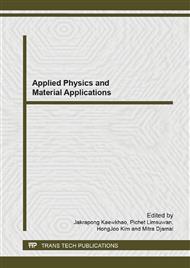[1]
ASTM C125-11a, Standard Terminology Relating to Concreate and Concrete Aggregate, 2011.
Google Scholar
[2]
R. Siddique, J. Klaus, Influence of metakaolin on the properties of mortar and concrete: A review, Appl. Clay Sci. 43 (2009) 392-400.
DOI: 10.1016/j.clay.2008.11.007
Google Scholar
[3]
J. Cabrera1, M. F. Rojas, Mechanism of hydration of the metakaolin-lime-water system, Cem. Concr. Res. 31 (2001) 177-182.
Google Scholar
[4]
G. Matekonis, R. Šiaučiūnas, D. Vaičiukynienė, Hydrothermal Synthesis and Characterization of Na+ and [Al3+ + Na+]-substituted Tobermorite in CaO-SiO2·nH2O-H2O System, Mater. Sci. 16 (2010) 242-248.
Google Scholar
[5]
P. Chindaprasirt, K. Pimraksa, A study of fly ash–lime granule unfired brick, Powder Technol. 182 (2008) 33-41.
DOI: 10.1016/j.powtec.2007.05.001
Google Scholar
[6]
S. Goňi, A. Guerrero, M.P. Luxán, A. Macías, Activation of the fly ash pozzolanic reaction by hydrothermal conditions, Cem. Concr. Res. 33 (2003) 1399-1405.
DOI: 10.1016/s0008-8846(03)00085-1
Google Scholar
[7]
A. Sepulcre-Aguilar, F. Hernández-Olivares, Assessment of phase formation in lime-based mortars with added metakaolin,Portland cement and sepiolite, for grouting of historic masonry, Cem. Concr. Res. 40 (2010) 66-76.
DOI: 10.1016/j.cemconres.2009.08.028
Google Scholar
[8]
K.L. Konan, C. Peyratout, A. Smith, J.-P. Bonnet, S. Rossignol, S. Oyetola, Comparison of surface properties between kaolin and metakaolin in concentrated lime solutions, J. Colloid Interface Sci. 339 (2009) 103-109.
DOI: 10.1016/j.jcis.2009.07.019
Google Scholar
[9]
M. Frías, R. Vigil, R. García, O. Rodríguez, S. Goñi, I. Vegas, Evolution of mineralogical phases produced during the pozzolanic reaction of different metakaolinite by-products: Influence of the activation process, Appl. Clay Sci. 56 (2012) 48-52.
DOI: 10.1016/j.clay.2011.11.022
Google Scholar
[10]
Y. Mleza, M. Hajjaji, Microstructural characterisation and physical properties of cured thermally activated clay-lime blends, Constr. Build. Mater. 26 (2012) 226-232.
DOI: 10.1016/j.conbuildmat.2011.06.014
Google Scholar
[11]
M. F. Rojas, Study of hydrated phases present in a MK–lime system cured at 60 °C and 60 months of reaction, Cem. Concr. Res. 36 (2006) 827-831.
DOI: 10.1016/j.cemconres.2006.01.001
Google Scholar
[12]
F. Cassagnab่re, G. Escadeillas, M. Mouret, Study of the reactivity of cement/metakaolin binders at early age for specific use in steam cured precast concrete, Constr. Build. Mater. 23 (2009) 775-784.
DOI: 10.1016/j.conbuildmat.2008.02.022
Google Scholar
[13]
M. F. Rojas, M.I. Sánchez de Rojas, The effect of high curing temperature on the reaction kinetics in MK/lime and MK-blended cement matrices at 60 oC, Cem. Concr. Res. 33 (2003) 643-649.
DOI: 10.1016/s0008-8846(02)01040-2
Google Scholar
[14]
D. S. Klimesch, A. Ray, DTA-TGA of unstirred autoclaved metakaolin-lime-quartz slurries. The formation of hydrogarnet, Thermochim. Acta 316 (1998) 149-154.
DOI: 10.1016/s0040-6031(98)00307-4
Google Scholar
[15]
R. García, R. Vigil de la Villa, O. Rodríguez, M. Frías, Mineral phases formation on the pozzolan/lime/water system, Appl. Clay Sci. 43 (2009) 331-335.
DOI: 10.1016/j.clay.2008.09.013
Google Scholar
[16]
S. Alonso, A. Palomo, Calorimetric study of alkaline activation of calcium hydroxide-metakaolin solid mixtures, Cem. Concr. Res. 31 (2001) 25-30.
DOI: 10.1016/s0008-8846(00)00435-x
Google Scholar
[17]
S. Alonso, A. Palomo, Alkaline activation of metakaolin and calcium hydroxide mixtures: influence of temperature, activator concentration and solids ratio, Mater. Lett. 47 (2001) 55-62.
DOI: 10.1016/s0167-577x(00)00212-3
Google Scholar
[18]
M. L. Granizo, S. Alonso, M. T. Blanco-Varela, A. Palomo, Alkaline Activation of Metakaolin: Effect of Calcium Hydroxide in the Products of Reaction, J. Am. Ceram. Soc. 85 (2002) 225-231.
DOI: 10.1111/j.1151-2916.2002.tb00070.x
Google Scholar
[19]
J. Davidovits, Geopolymers, Inorganic polymerie new materials, J. Therm. Anal. 37 (1991) 1633-1656.
Google Scholar
[20]
P. C. Hewlett, Lea's Chemistry of Cement and Concrete, fourth ed., Special Cement, Linacre House, Jordan Hill, Oxford, UK, 1988, pp.783-840.
Google Scholar


